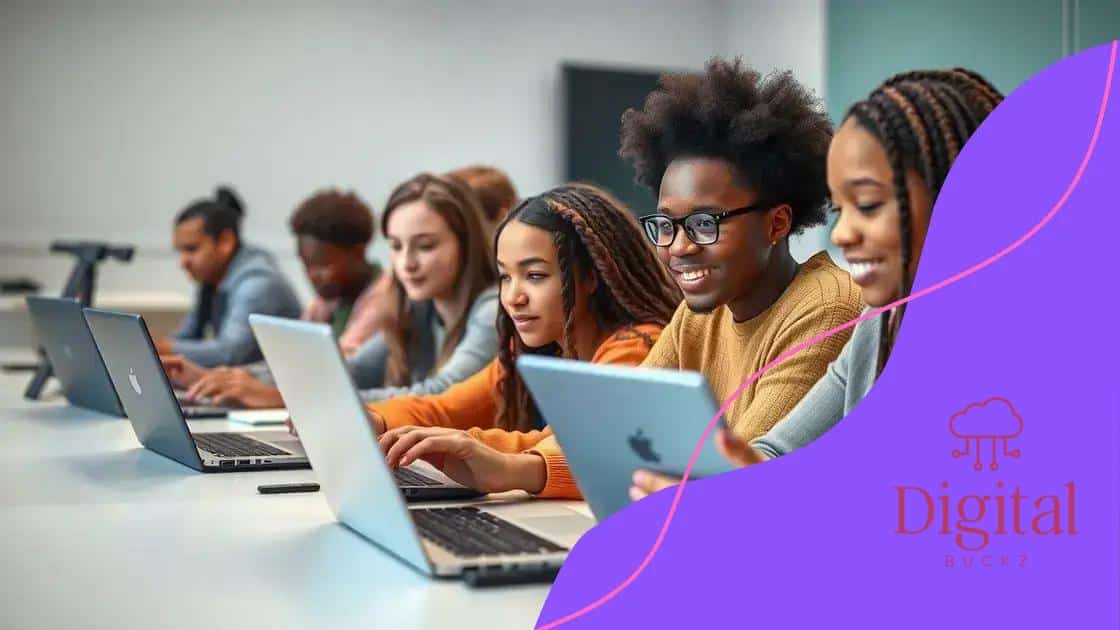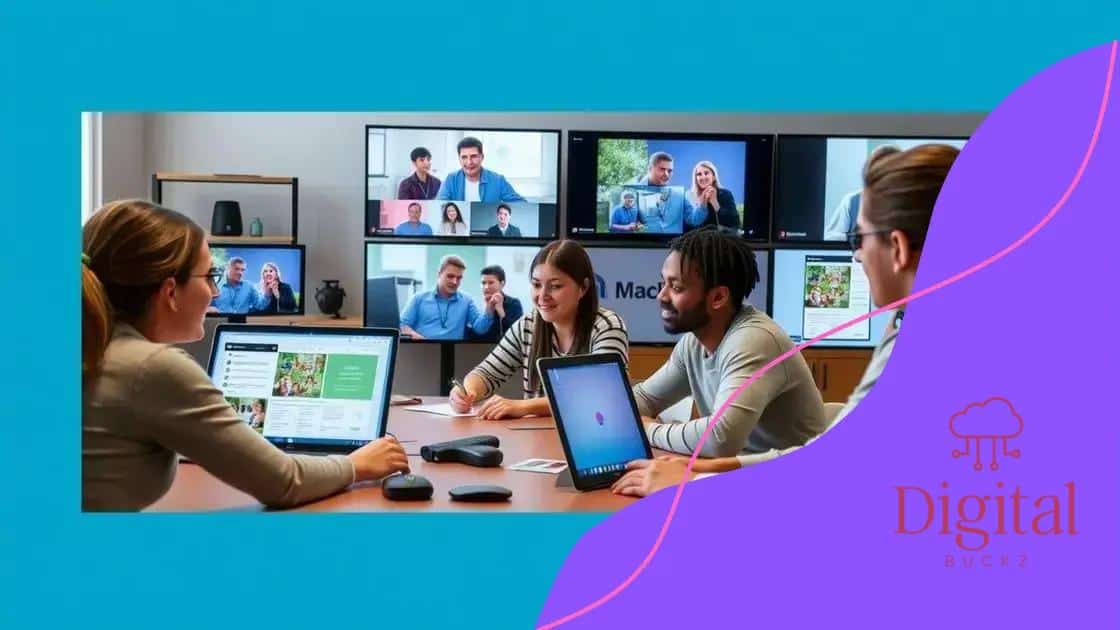How edtech is enhancing remote education access

EdTech enhances remote education access by providing flexible online learning tools, enabling personalized education, and fostering collaboration among students through advanced technologies like AI and immersive experiences.
In today’s world, how edtech is enhancing remote education access has become a crucial topic. With traditional learning methods evolving, it’s worth exploring how technology can bridge gaps and provide richer educational experiences.
The rise of edtech in remote education
The rise of edtech in remote education has transformed how students learn from home. These tools are designed to overcome the challenges posed by traditional methods.
Growth of Online Learning Platforms
Online learning platforms have become essential for both teachers and students. They provide an array of resources and flexible learning opportunities. This shift allows for greater accessibility to education regardless of location.
Advantages of Educational Technology
- Increased engagement through interactive content
- Access to diverse learning materials
- Customized learning experiences tailored to individual needs
These advantages show how edtech is balancing accessibility with quality education. Students can learn at their own pace and revisit difficult concepts, which enhances understanding.
Moreover, the integration of technology has promoted collaboration among learners. Virtual classrooms allow peers to work together, share insights, and assist each other in real-time. This sense of community supports motivation and accountability.
Impact on Educators
Educators also benefit from the rise of edtech. They can track student progress more effectively and adapt their teaching strategies accordingly. With tools that offer analytics and feedback, teachers can identify strengths and areas needing improvement.
In conclusion, the emergence of educational technology has created profound changes in remote education. As we continue to embrace these advancements, the future looks bright for both learners and educators alike in accessing quality education.
Benefits of online learning tools
Online learning tools offer a variety of advantages that enhance the educational experience. These tools are designed to improve access, engagement, and effectiveness in learning.
Increased Flexibility
One of the main benefits of online learning tools is increased flexibility. Students can learn at their own pace, choosing when and how they engage with the material. This allows personalized learning paths, catering to individual needs.
Interactive Learning Experiences
- Multimedia resources like videos and quizzes enhance engagement.
- Collaborative tools foster group work and communication.
- Gamification elements make learning fun and motivate students.
These interactive features help keep students interested in their studies. By incorporating different types of content, online tools meet various learning styles.
Moreover, online platforms can provide immediate feedback. This feedback allows students to understand their progress and improve in real-time. Knowing where they excel and where they need help makes learning more effective.
Access to a Wider Range of Resources
Online learning tools also grant access to a wealth of resources. Students can explore materials from around the world without geographical limitations. This richness provides varied perspectives, broadening students’ knowledge and understanding.
In addition, many online tools come with built-in analytics. These analytics give educators insights into student performance, helping them tailor their teaching strategies to meet diverse learning needs.
How virtual classrooms foster collaboration

Virtual classrooms play a significant role in fostering collaboration among students. These digital environments create opportunities for learners to interact and engage with one another, regardless of their physical locations.
Real-Time Communication
In a virtual classroom, students can communicate with each other and their teachers instantly. Video conferencing tools allow for face-to-face interactions, making discussions more dynamic. This instant communication helps build relationships and encourages teamwork.
Group Projects and Activities
- Students can work together on group projects from any location.
- Collaborative tools enable shared editing of documents and presentations.
- Interactive brainstorming sessions foster creativity and idea exchange.
These group activities enhance critical thinking and problem-solving skills. When students collaborate, they learn from one another, gaining different perspectives and insights.
Moreover, virtual classrooms often include forums and discussion boards. These platforms give students the chance to express their ideas and support each other even outside live sessions. It promotes a sense of community and belonging, which is vital for effective learning.
Access to Diverse Perspectives
Collaboration in virtual classrooms also allows learners to connect with peers from diverse backgrounds. This exposure enriches the learning experience, as students can share their unique insights and cultural experiences. Such interactions challenge narrow viewpoints and promote global awareness.
As technology continues to evolve, the potential for collaboration in virtual classrooms will only grow. The integration of new tools and features will further enhance the ways in which students connect, cooperate, and learn together, creating a more inclusive and dynamic educational landscape.
Challenges faced by remote learners
Remote learners encounter a variety of challenges that can impact their educational experience. While online education offers many benefits, it also presents hurdles that students must navigate.
Limited Access to Technology
One major challenge is limited access to technology. Not all students have reliable devices or internet connections. This can create obstacles in engaging fully with online classes and resources, leaving some learners at a disadvantage.
Distractions and Time Management
- Learning from home can bring distractions that affect focus.
- Students may struggle to manage their time effectively without a structured environment.
- Finding a quiet space for study can be a challenge for many.
These distractions can lead to difficulties in completing assignments and maintaining motivation. Students must cultivate self-discipline to stay on task.
Additionally, the lack of face-to-face interaction can lead to feelings of isolation. Many students miss the social interactions that come with traditional schooling. This absence can impact mental health and overall engagement in learning.
Adapting to Online Learning Styles
Adapting to different learning styles in a remote environment can also be difficult. Not every student thrives in online formats. Some learners prefer hands-on experiences or in-person guidance. This shift requires flexibility and a willingness to embrace new learning methods.
Instructors need to recognize these challenges and support their students. Providing resources, understanding individual needs, and fostering a supportive online community can help mitigate some of these issues. By addressing these obstacles, educators can enhance the remote learning experience.
Future trends in educational technology
The future trends in educational technology are shaping how we approach learning and teaching. As technology continues to evolve, new tools and methods emerge that enhance the educational experience for students and educators alike.
Personalized Learning
One significant trend is the rise of personalized learning. This approach uses data and analytics to tailor educational experiences to individual student needs. By analyzing students’ performance, educators can customize lessons, assignments, and resources. This helps ensure that every learner is engaged and challenged appropriately.
Artificial Intelligence Integration
- AI can provide real-time feedback to students.
- Intelligent tutoring systems offer personalized guidance.
- Chatbots can assist students outside of regular classroom hours.
With the integration of artificial intelligence, educational tools can become more responsive and interactive, making learning more accessible and efficient.
Additionally, the use of virtual and augmented reality is on the rise. These technologies allow students to explore immersive learning environments. For example, they can take virtual field trips or conduct simulations that deepen their understanding of complex subjects.
Focus on Collaboration Tools
Future educational platforms are expected to focus on enhancing collaboration among students. New tools will promote teamwork through shared projects, fostering communication between peers. This collaborative environment supports social learning, helping students develop vital teamwork and interpersonal skills.
Moreover, gamification continues to gain traction. By incorporating game elements into learning, educators can boost student engagement and motivation. Students are more likely to participate actively when their learning feels less like traditional education and more like a game.
FAQ – Frequently Asked Questions About EdTech and Remote Education
What is EdTech and why is it important?
EdTech refers to the use of technology in education. It is important because it enhances learning experiences, increases accessibility, and enables personalized education for students.
How do online learning tools improve student engagement?
Online learning tools improve engagement through interactive content, gamification, and real-time feedback, making learning more enjoyable and motivating for students.
What challenges do remote learners face?
Remote learners may struggle with issues like limited access to technology, distractions at home, time management, and feelings of isolation without face-to-face interaction.
What trends are shaping the future of educational technology?
Key trends include personalized learning, AI integration for customized experiences, and the use of immersive technologies like VR and AR to enhance engagement.






